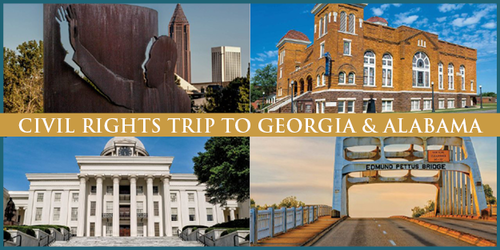- Worship
- Education
- Lifecycle
- Events & Programs
- About Us
- Join Us
- Donate
Civil Rights Trip to Georgia & Alabama
Civil Rights Trip to Georgia & Alabama
FEBRUARY 5–7, 2024
trip updates
Day Three – Wednesday, February 7
The last day of our trip was pretty intense. We began the day at the National Memorial for Peace and Justice, a tremendous exhibit memorializing more than 4400 Black people killed in racial terror lynchings between 1877 and 1950. The name “national” does not indicate any connection to the government, but rather the fact that this was the first memorial dedicated to honoring those victims and its creators got to choose the name. As one of the signs on the exhibit explains, “Lynchings in America were not isolated hate crimes committed by rogue vigilantes. Lynchings were targeted racial violence perpetrated to uphold an unjust social order.” It is estimated that fewer than 1% of the participants in these lynchings were every prosecuted. Unfortunately, we know similar stories from Jewish history.
Some pointed out the similarities between this memorial and Yad Vashem or other Holocaust memorials. I remember how I felt when visiting the Holocaust sites and seeing non-Jewish tourists coming to witness “my” story, and I imagine how Black people might feel seeing a group of White Jews coming to witness “their” story. The story of Civil Rights in America is not our story to tell or control; but we felt privileged to witness the history as Jews.
Following the memorial, we visited the Legacy Museum, which documents the story “from enslavement to mass incarceration.” Both the museum and the memorial are projects of the Equal Justice Initiative, the group Bryan Stevenson. The museum begins with the slave ships and moves its way through Reconstruction, Jim Crow, Segregation, and Mass Incarceration. The experience is incredibly powerful and we should be grateful that the story is being told.
After a quick pizza lunch, we gathered together for final reflections. We expressed gratitude to our wonderful guide, Billy Planer – I am personally grateful for the opportunity to have spent time with the man who was once my youth director. And I offered a final prayer. It was a spontaneous prayer, but it went something like this:
O God, we are grateful for the opportunity to have come on this trip to hear the story of Civil Rights.
Bless our feet, which prayed as we walked the paths of those who came before us.
Bless our eyes, which were blessed to witness the fight for justice.
Bless our minds, with which we continue to process the meaning of all we have experienced.
And Bless our hands, that they might engage in the work of creating and repairing our World of Justice.
Amen.

The National Memorial for Peace and Justice sits on top of a hill overlooking downtown Montgomery, as if to underscore the message that injustice happens all around us, even if we don’t always notice. It recalls the famous quote of Elie Wiesel, “The opposite of love is not hate, it’s indifference. The opposite of art is not ugliness, it’s indifference. The opposite of faith is not heresy, it’s indifference. And the opposite of life is not death, it’s indifference.”
Day 2 – Tuesday, February 6
Today we visited Selma, Alabama, and learned some of the history that led up to the march from Selma to Montgomery. We learned how the Southern Christian Leadership Conference was not initially interested in organizing in Selma. We learned about the murder of Jimmy Lee Jackson— how he was shot when he tried to stop a police officer from beating his 82-year-old grandfather who was registering to vote. We learned how the march was actually three marches—college students marched across the bridge on Sunday April 4, 1963, (Bloody Sunday) and were beaten back by the police. A second march was thwarted on Tuesday, April 6. On Thursday, April 8, King led a march (this time, with a permit), and the same troops who had beaten marchers on Sunday were now charged with protecting them throughout the journey.
In Montgomery, we walked the two-block path from where Rosa Parks boarded a bus on December 1, 1955, to where she was arrested for refusing to give up her seat. We visited the Rosa Parks museum, which tells the story of her arrest, but also of the mass arrests and logistical complications involved in organizing a boycott in just a few days and then sustaining it for 381 days—that’s 381 days of Blacks being threatened with losing their jobs, 381 days of organizing rides, 381 days of getting around laws restricting the ability to pay for “unauthorized” rides or carry more than a few passengers in a car. That 381-day boycott changed the law in Montgomery and ignited an entire movement.
Reflections from Vickie Abrutyn
We began our day today in Selma Selma is so impoverished, it is hard to believe it could ever return to what it was; and even then, it was a mostly Black, poor city. We walked the Edward Pettus Bridge, the starting place of the march from Selma to Montgomery, initiated to honor he memory of Jimmy Lee Jackson and earn the guaranteed right to vote for Black people. I knew some of the story of the 1963 Bloody Sunday march, but not as much as I know now. We met Joanne Blackman Bland who was 11-years-old when she and her 13-year-old sister joined the march.
Joanne told us the police gave them two minutes to turn around that day, but they only waited about 15 seconds before attacking them from the front, back, and sides on horseback and on foot.
Joanne related that as a little girl she used to walk by Carter’s Drug store on the main street. She would look in the window and see little girls sitting at the counter and swinging around on the swivel chairs. She asked her mama if she could do that, and she was told it was only for White children. “That is why I joined the Civil Rights movement,” she told us.
Joanne reiterated that the Civil Rights movement was made up of the people. Martin Luther King only came to town later when he was invited, but never stayed long and was not a primary organizer of the march. She told us that members of many denominations and from many places came to March and the reason we don’t see Rabbi Joshua Heschel in pictures was that the organizers rotated folks from different denominations so they could all have an opportunity to stand near Dr. King. Rabbi Heschel (or, Rabbi Santa Claus, as some called him) was not in every one of the pictures.
As an aside, we were told at the synagogue last night that as a result of his involvement with the Civil Rights movement (and his opposition to the Vietnam War) Rabbi Heschel was ostracized by much of the leadership and faculty at the Seminary in those years.
To get you back to the Bridge, Joanne’s sister received blows to her head requiring 48 stitches. The walkers were turned back that Sunday only to return five days later after the governor ordered the same police to escort them across the bridge. The walk took five days and required a tremendous amount of organizing. There were no hotels along the road, so arrangements had to be made for marchers to sleep outside on Black owned properties. Food had to be provided as well as tents. We learned about Viola Liuzzo, the White activist from Detroit who was killed by a group of Klansman. There were many others who participated, some losing their lives, to make this march successful.
Strange to think, as I did walking across that bridge that all these years later, that we still have a Voting Rights Act but so many states are still trying to find ways to weaken it. The work our synagogue is doing to engage and talk and work for change is so important.
The afternoon took us to the Rosa Parks Museum. An interactive presentation put us all on the bus with her the day she was arrested. The more we see and learn the more I realize how much more is still to be done.
Reflections from Allan Goodman
On the second day of our trip we traveled to Selma, Alabama the site of the Edmund Pettus Bridge which crosses the Alabama River. Edmund Pettus was a Confederate brigadier general, U.S. senator, and state-level leader (Grand Dragon) of the Alabama Ku Klux Klan. On “Bloody Sunday,” March 7, 1965, police attacked Civil Rights Movement demonstrators with horses, billy clubs, and tear gas as they crossed the bridge as they attempted to begin to march to the state capital, Montgomery.
We were extremely fortunate and honored to meet with one of the demonstrators, Joanne Bland, a proud lifetime member of the Selma community and a US army veteran who was eleven years on Bloody Sunday when she crossed the bridge with her fourteen year old sister Linda. Joanne spoke with us about her experience, describing herself as a survivor of Bloody Sunday, as both she and Linda were beaten by the police. As the result of media attention and political outcry, fourteen days later, demonstrators, accompanied by Dr. Martin Luther King and other leaders of the movement were allowed to march to Montgomery from Selma. Joanne and Linda participated in the 53 mile, five day walk. To hear her story in person was inspiring, emotional and powerful. It was truly sobering . She emphasized that the efforts of the community in Selma “were a catalyst for the passing of the Voting Rights Act” which she noted has been under attack since its passage. Today, 43 states are attempting to enact laws which will suppress voting in various ways. As Joanne said, the work is not done.
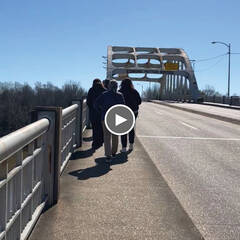 After meeting with Joanne, the group walked across the Edmund Pettus Bridge and gathered in the park at the foot of the bridge, with monuments commemorating the organizers and participants of the march.
After meeting with Joanne, the group walked across the Edmund Pettus Bridge and gathered in the park at the foot of the bridge, with monuments commemorating the organizers and participants of the march.
We then traveled to Montgomery, where we visited the site where on December 1, 1955, Rosa Parks boarded a bus and within minutes rejected the bus driver’s order to vacate a row of four seats in the "colored" section in favor of a white passenger to allow white passengers to be seated. The driver called police, who arrested Ms. Parks.
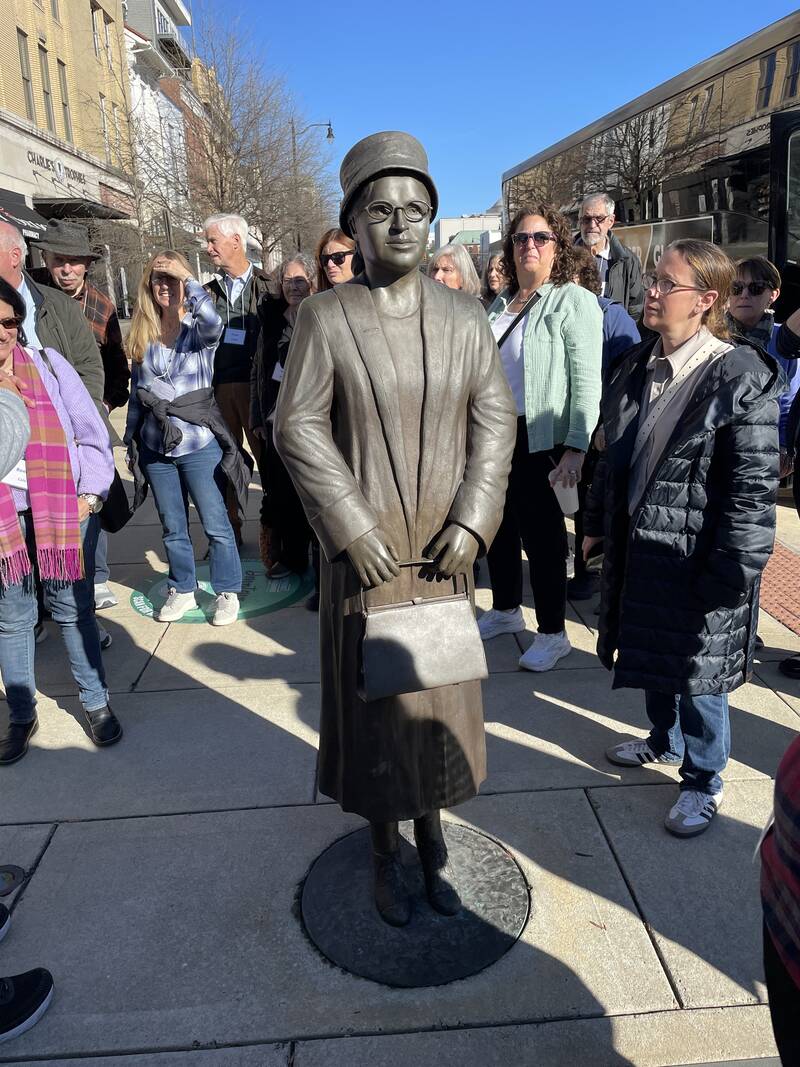 We visited the Rosa Parks Museum, where we watched videos and an enactment of Rosa Parks encounter with the bus driver and her arrest. Billy guided us through the museum, adding detail to the exhibits which explained the subsequent events to Ms. Parks arrest, including the more than year long bus boycott by the community which bankrupted the bus line. We concluded the day by visiting The Southern Poverty Law Center and the memorial to the Civil Rights Movement which contains a time line of the movement from Rosa Park’s arrest until Martin Luther King’s death.
We visited the Rosa Parks Museum, where we watched videos and an enactment of Rosa Parks encounter with the bus driver and her arrest. Billy guided us through the museum, adding detail to the exhibits which explained the subsequent events to Ms. Parks arrest, including the more than year long bus boycott by the community which bankrupted the bus line. We concluded the day by visiting The Southern Poverty Law Center and the memorial to the Civil Rights Movement which contains a time line of the movement from Rosa Park’s arrest until Martin Luther King’s death.
At the end of the day we gathered at the hotel to discuss our impressions about the trip.
Day One, February 5, 2024
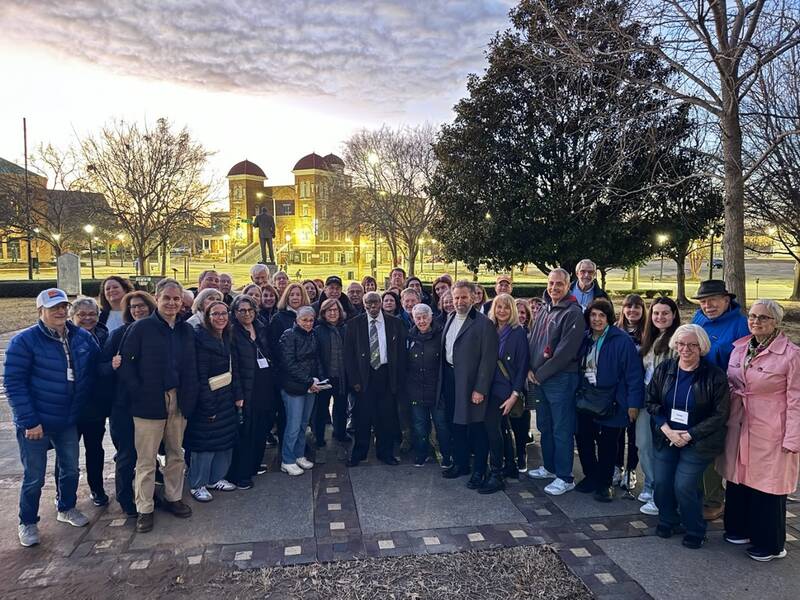
Reflections by Rabbi Michael Safra
There was a special excitement when our group of 46 met in the North Terminal Baggage Claim at Atlanta Hartsfield-Jackson International Airport this morning. Having grown up in Atlanta, it felt good to welcome people to “my city.” We weren’t here so much to “visit” as much as to “experience” the history and nuances of the Civil Rights Movement. We stopped for a short time on Auburn Avenue, home to the city’s largest Black business and commercial district before it was bisected by the construction of Interstate 85. We met together in a park situated between Ebenezer Baptist Church and the King Center. This is the church where Rev. Dr. Martin Luther King, Jr.’s father and grandfather pastored, and it is the place where King and his wife, Coretta Scott King, are buried. It is also a monument to nonviolence.
After a quick lunch, we headed down I-20 to Birmingham (known also as the Magic City, the City of Controversy, the City of Tragedy, and, for a time, Bombingham). We were delayed for a short time because of an issue with the bus, but somehow we got back on schedule. We visited Freedom Park, situated across the Street from the 16th Street Baptist Church. It is there that we met Bishop Calvin Woods, Sr. Bishop Woods is 90 years old and retired, but that didn’t stop him from teaching, preaching, and enlivening us with his distillation of the divine spirit. Our group was mesmerized. After dinner, we were hosted by the Civil Rights Committee at Temple Beth El, the Conservative synagogue in Birmingham, which presented its own version of the Civil Rights Experience, which explored the complicated relationships between Birmingham’s Jews and the Movement.
I reflect on two thoughts our guide, Billy Planer, shared in his introduction. The first is that the Civil Rights story is not “our” story. Many Jews played important roles in the Civil Rights Movement, but the story does not belong to us. And it shouldn’t necessarily surprise us that Jews are sometimes left out when Blacks tell their version of their story.
The second is that two of the most prominent Jews in the Civil Rights Movement, Andrew Goodman and Michael Schwerner, did not themselves identify as Jews. Both were born Jewish, but Schwerner did not consider himself a part of the Jewish community and Goodman considered himself an atheist. Billy pointed out that they lived in a time before our modern notion of tikkun olam had been popularized and he wondered whether, if they had had Jewish language to articulate their activist passions, they might have identified more closely with their Judaism. That thought suggests an interesting perspective for our era when “engagement” is a defining mantra for organized Jewish life. Social justice initiatives offer an important portal for Jews to enter Jewish life and express Jewish identity in meaningful ways.
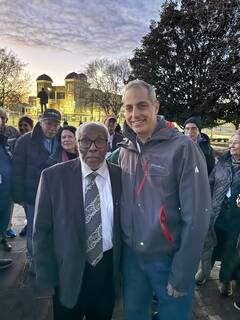
Our group meets with Rev. Woods in Freedom Park. The 16th-Street Baptist Church is in the Background.
Reflections from Karen Post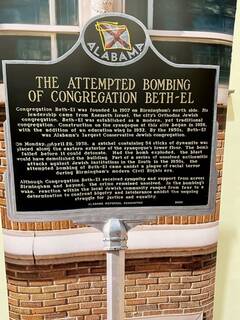
Tonight we had the pleasure of participating in the Civil Rights Experience hosted by Congregation Beth-El in Birmingham, Alabama. We learned about the attempted bombing at the synagogue in April 1958. Fortunately, the bomb failed to detonate. Some theorize that it was never intended to go off, and that it was planted simply as a warning to the Jewish community not to get involved in the civil rights movement. Others theorize that the bomb did not go off because it had rained, preventing the dynamite from exploding. We’ll never know the truth, but either way we are fortunate that the beautiful structure was not destroyed and that no one was hurt or killed.
We discussed how the Jewish people—like all peoples—are not monolithic. Some Birmingham Jews were not involved in any way in the civil rights struggle taking place in their own city. Some were minimally involved. These people knew that the situation with the Blacks was immoral, yet they were hesitant to get too involved in “other people’s issues.” And then there were some Jews who advocated aggressively for equal rights.
One Beth-El congregant recounted in a short film that we watched that, as a White Jewish teenager in Birmingham, she was ignorant of what was going on in her own city. She had asked her Black maid for whom she was going to vote in an upcoming election, and was shocked to learn that her maid, along with the maid’s friends and family, were unable to vote because there was a poll tax that they did not have enough money to pay. The woman knew absolutely nothing about this. She knew nothing about the violence Blacks were facing in Birmingham. She lived an insular life. The news media in Birmingham was not reporting on what was happening in the city, and so she remained ignorant of the tragedies unfolding in her own backyard. This made me think about how, in today’s world, with news being sent to our cell phones 24/7, it would be impossible not to know. Yet, even though we all know about the continuing struggles of Black Americans, as stated earlier, we are not monolithic. Some knowingly turn a blind eye, some are bothered yet don’t get involved, and some are strong advocates. The more things change, the more they remain the same.
Reflections from Jonathan Salant
When Rabbi Safra returned from the rabbis' civil rights tour last year, I knew that we had to do a program on his visit. And when he said wanted to arrange a synagogue civil rights trip, I knew we had to go on it.
After all, this was one of the righteous social movements that we as Jews naturally would be a part of. And it's no accident that some of the most well known names came from Jewish households, remembering that Jews are not only a religion but a people as well.
Growing up watching the images of dogs being sicced on peaceful protesters on the nighly news, or reading about the struggle against segregation and for equal rights in the newspapers, it was especially meaningful to see these places first hand for the first time. And the participation of Jewish Americans probably was the first time I saw tikkun olam in practice.
Event description
We hope you can join us for this important experience. This special Civil Rights journey uses the history, sites, and current issues as a springboard to highlight the relationship, and at times, the tension, of the Jewish and American identity. The journey will be a mix of fun, sightseeing, education, and meetings with organizations and people who have been and are still involved in creating America.
Participants will learn about the struggles of African Americans to gain equality in the 1950s & 60s and explore how Jews were involved in the struggle for Civil Rights. Participants will walk away understanding why Jews, as people who have known oppression, must care and act when others are oppressed.
The trip stops in Atlanta, Montgomery, Selma, and Birmingham, with visits to the Equal Justice Initiative Legacy Museum and Memorial to the victims of lynching, Freedom Park, the site where Leo Frank was lynched, the Rosa Parks Museum, the Martin Luther King Center/Auburn Ave. District, Ebenezer Baptist Church, walking across the Edmund Pettus Bridge, and the 16th Street Baptist Church.
Sat, July 27 2024
21 Tammuz 5784
Livestream
Shabbat Services
Friday at 6:15 PM
Saturday at 9:00 AM
the latest
They Shall Not Be Cut Off (Parshat Naso, June 15) by Rabbi Mitchell Berkowitz
announcements
Summer at B'nai Israel
Click here for the latest on our Summer offerings including Speaker Series, Beit Midrash, later Kabbalat Shabbat, outdoor services, and more!
TEEN Civil Rights Trip this November
Join us for a special opportunity for 9-12th graders. Learn more.
NEW Hebrew High Launches for Grades 9–12
Our program is designed with the interests and schedules of teens in mind. Check it out.
Schilit Nursery School AND Lessans Talmud Torah registration for 2024–2025 is open!
Very limited spaces remain for our 2024–25 Schilit Nursery School - we can't wait to meet you! Registration is also open for our Lessans Talmud Torah (Grades K–8).
B'nai Israel First Synagogue in North America to Install RightHear, supporting those who are blind or low vision.
Read our press release here.
NEW Resource: Fighting Antisemitism
Raise Awareness, Educate, and Act to stop antisemitism. Learn more.
Join Our Shabbat Morning Livestream
Click here to access.
Explore Our Exciting Adult Education Offerings
Learn more here.
weekday services
Sunday | 9:00 AM & 8:00 PM
Monday–Thursday | 7:15 AM & 8:00 PM
Friday | 7:15 AM
*Service times vary on holidays.
Click here for access information.
shabbat services
Friday | 6:15 PM (7:00 PM during Summer)
Saturday | 9:00 AM & 12:30 PM (Minha)
Click here for access information.
inclement weather policy
Click here for information.


